FAQ & Complete User Guide
Your comprehensive guide to mastering Syntry. From basic documentation to advanced workflow features, everything you need to maximize your clinical efficiency.
Complete Table of Contents
Core Features
Workflow Tools
Advanced & Support
New to Syntry?
Start with our Getting Started guide for a step-by-step walkthrough
Complete User Guide Navigation
Documentation Styles
Choose from three AI-powered documentation styles that adapt to your clinical practice and preferences.
Structured
Organized bullet points and clear sections
Narrative
Natural paragraph flow and storytelling
Adaptive
Smart mix based on content complexity
Structured Style Example
Perfect for organized, bullet-point documentation with clear sections
• Chest pain x 3 days
• 45-year-old female
• Sharp, left-sided chest pain
• Worse with deep inspiration
• Recent international travel (10 days ago)
• No associated dyspnea or leg swelling
• Vital signs: BP 120/80, HR 88, RR 16, O2 98%
• Cardiac: RRR, no murmurs
• Pulmonary: Clear bilaterally
• Extremities: No edema or calf tenderness
• Pleuritic chest pain, rule out PE
- Wells score: 4.5 (moderate risk)
- D-dimer ordered
- Chest X-ray WNL
- If D-dimer elevated → CTPA
• Patient counseled on PE precautions
• Return if worsening symptoms
Narrative Style Example
Natural paragraph flow for comprehensive storytelling documentation
Chief Complaint: This 45-year-old female presents with a three-day history of sharp, left-sided chest pain that has been progressively concerning her.
History of Present Illness: The patient describes the pain as sharp and stabbing in nature, primarily localized to the left lateral chest wall. She notes that the pain is significantly worse with deep inspiration and has been persistent over the past three days. Importantly, she recently returned from international travel to Europe ten days ago, involving a long-haul flight. She denies any associated shortness of breath, leg swelling, or calf pain. The pain has not responded well to over-the-counter analgesics.
Physical Examination: On examination, the patient appears comfortable at rest but demonstrates discomfort with deep inspiration. Vital signs are stable with blood pressure 120/80, heart rate 88 and regular, respiratory rate 16, and oxygen saturation 98% on room air. Cardiac examination reveals regular rate and rhythm without murmurs, rubs, or gallops. Pulmonary examination shows clear breath sounds bilaterally without wheezes, rales, or rhonchi. Extremity examination is notable for the absence of edema or calf tenderness.
Medical Decision Making: Given the patient's presentation of pleuritic chest pain in the setting of recent long-haul travel, there is moderate concern for pulmonary embolism with a Wells score of 4.5. I have ordered a D-dimer level and obtained a chest X-ray, which appears normal. Depending on the D-dimer results, we may proceed with CT pulmonary angiography. The patient has been counseled extensively about the signs and symptoms that would warrant immediate return to the emergency department, including worsening dyspnea, chest pain, or leg swelling.
Adaptive Style Example
Smart combination of structured and narrative based on content complexity
This 45-year-old female presents with sharp, left-sided chest pain that began three days ago. The pain is pleuritic in nature and significantly worse with deep inspiration. She recently returned from international travel to Europe (10 days ago) involving a long-haul flight. She denies dyspnea, leg swelling, or calf pain.
• Vital signs: BP 120/80, HR 88, RR 16, O2 98% on RA
• Appears comfortable at rest, discomfort with deep inspiration
• Cardiac: RRR, no murmurs, rubs, or gallops
• Pulmonary: CTAB, no wheezes or rales
• Extremities: No edema or calf tenderness
Pleuritic chest pain, rule out pulmonary embolism (Wells score 4.5 - moderate risk)
Given the patient's recent travel history and pleuritic symptoms, there is moderate concern for PE. I have obtained a chest X-ray which is normal and ordered a D-dimer level. If the D-dimer is elevated, we will proceed with CT pulmonary angiography. The patient has been thoroughly counseled about PE warning signs and instructed to return immediately for worsening dyspnea, chest pain, or development of leg swelling.
AI Insight: Adaptive style automatically chose structured format for examination findings (easier to scan) and narrative format for complex clinical reasoning (better flow).
Visual Cards Interface
Syntry provides a modern, intuitive interface designed for healthcare professionals with visual cards that enhance your clinical workflow.
Visual Cards System
-
Clinical Decision Support: Visual calculators and risk assessment tools
-
Interactive Cards: Touch-friendly interfaces for mobile and tablet use
-
Persistent Display: Cards remain accessible throughout your encounter
-
Custom Calculations: Specialty-specific tools and calculators
Enhanced User Experience
-
Dark Mode Support: Eye-friendly interface for extended use
-
Responsive Design: Optimized for desktop, tablet, and mobile devices
-
Drag & Drop Zones: Visual feedback for file upload areas
-
Progress Indicators: Clear feedback during AI processing and analysis
-
Floating Navigation: Easy access to frequently used features
Encounter Management
-
Rich Text Editing: Advanced formatting options for clinical notes
-
Auto-Save Functionality: Never lose your work with continuous saving
-
Version History: Track all changes with complete edit history
-
Export Options: Multiple formats for EMR integration
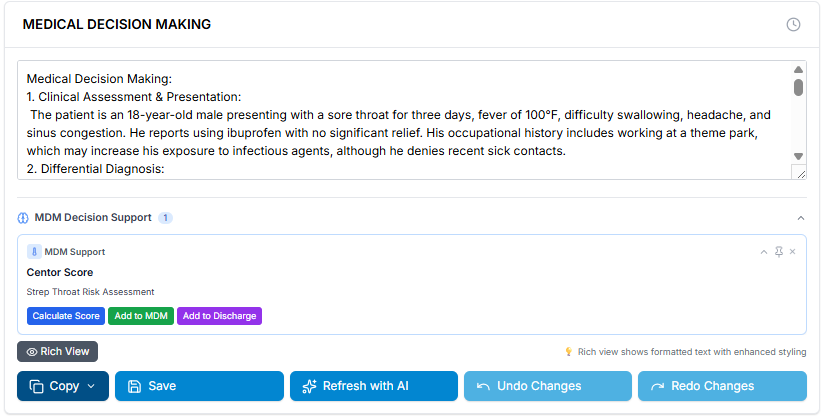
Interactive visual cards providing clinical decision support and intuitive workflow management
Pro Tip: Visual Workflow Optimization
The visual cards interface adapts to your screen size and usage patterns. On tablets, cards become larger and more touch-friendly, while on desktop they provide detailed information at a glance. Take advantage of the persistent display to keep important clinical tools visible throughout your encounter documentation process.
How to Use Syntry
Follow these step-by-step guides to master Syntry and streamline your clinical documentation workflow.
1. Getting Started - New Dashboard
Your dashboard is your home base. Here you can:
- View all your encounters
- Start new encounters
- Access settings and help
- Search and filter past encounters
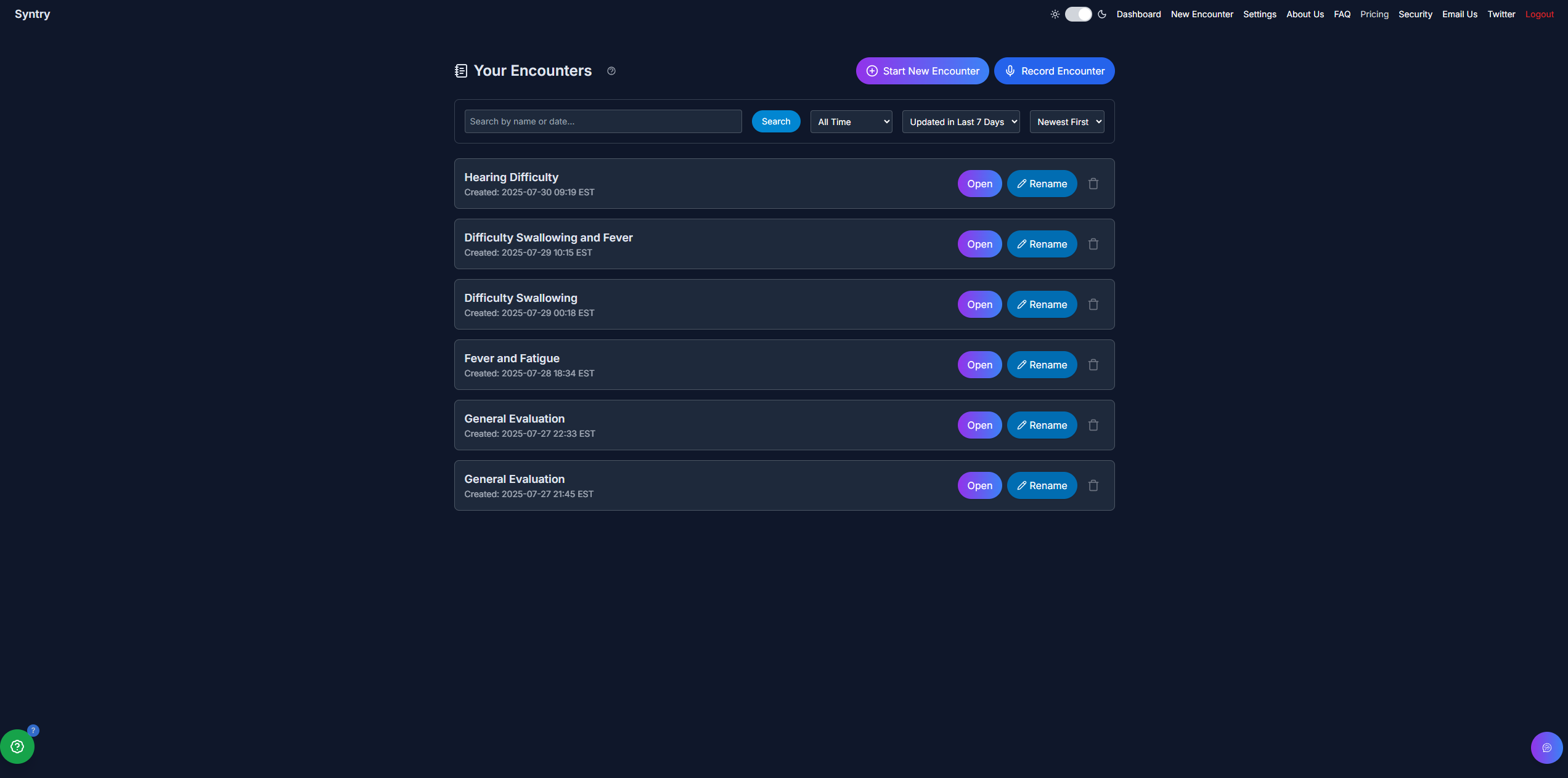
2. Starting a New Encounter
Click "Start New Encounter" to begin:
- Choose between Recording or Manual entry
- Recording: Use your microphone to dictate
- Manual: Type notes directly
- Both options generate professional documentation
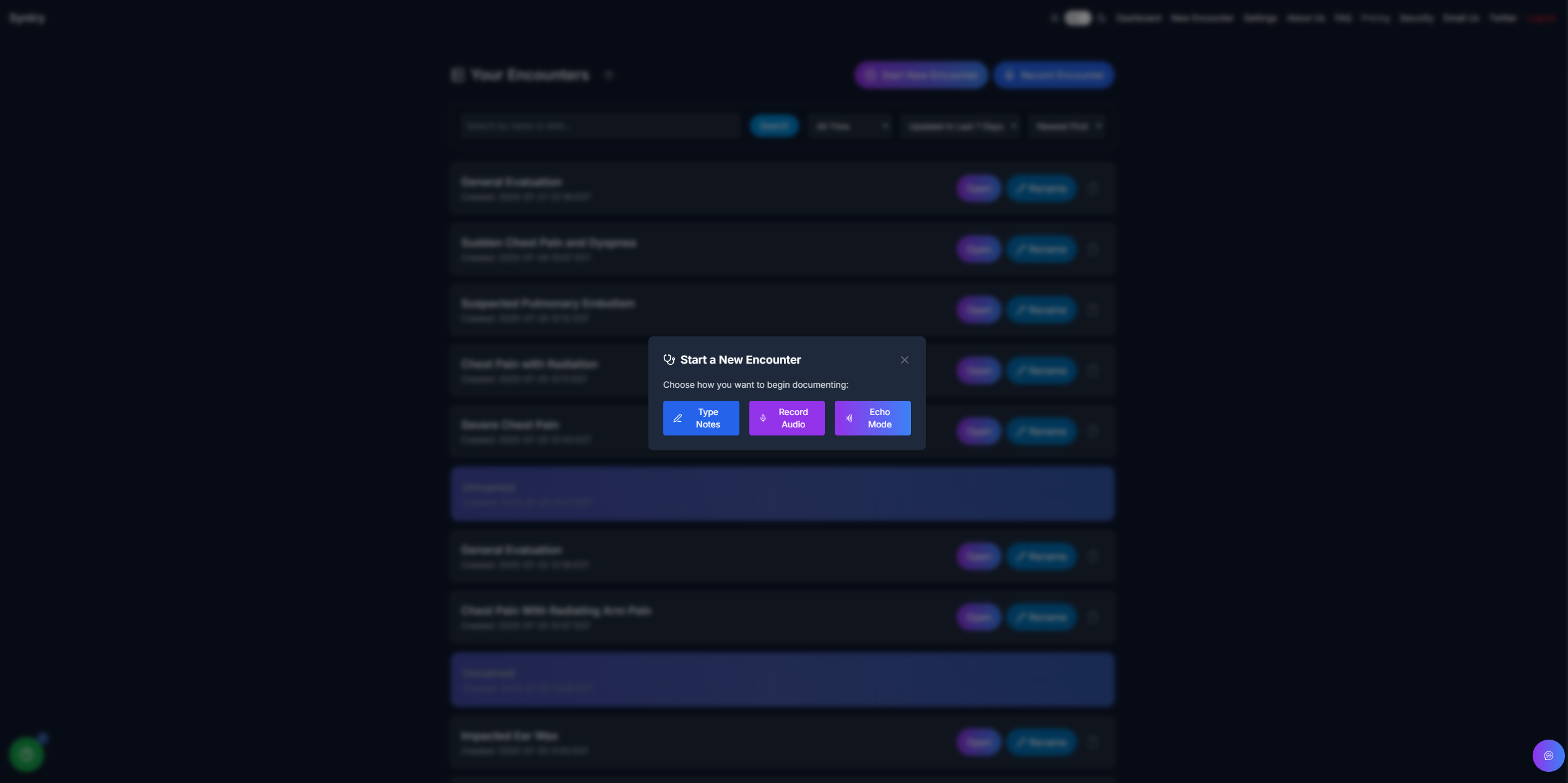
3. Recording Your Encounter
The recording modal provides:
- Real-time audio waveform visualization
- Clear recording status indicator
- Tap the microphone circle to stop
- Audio is processed immediately
- No audio files are permanently stored
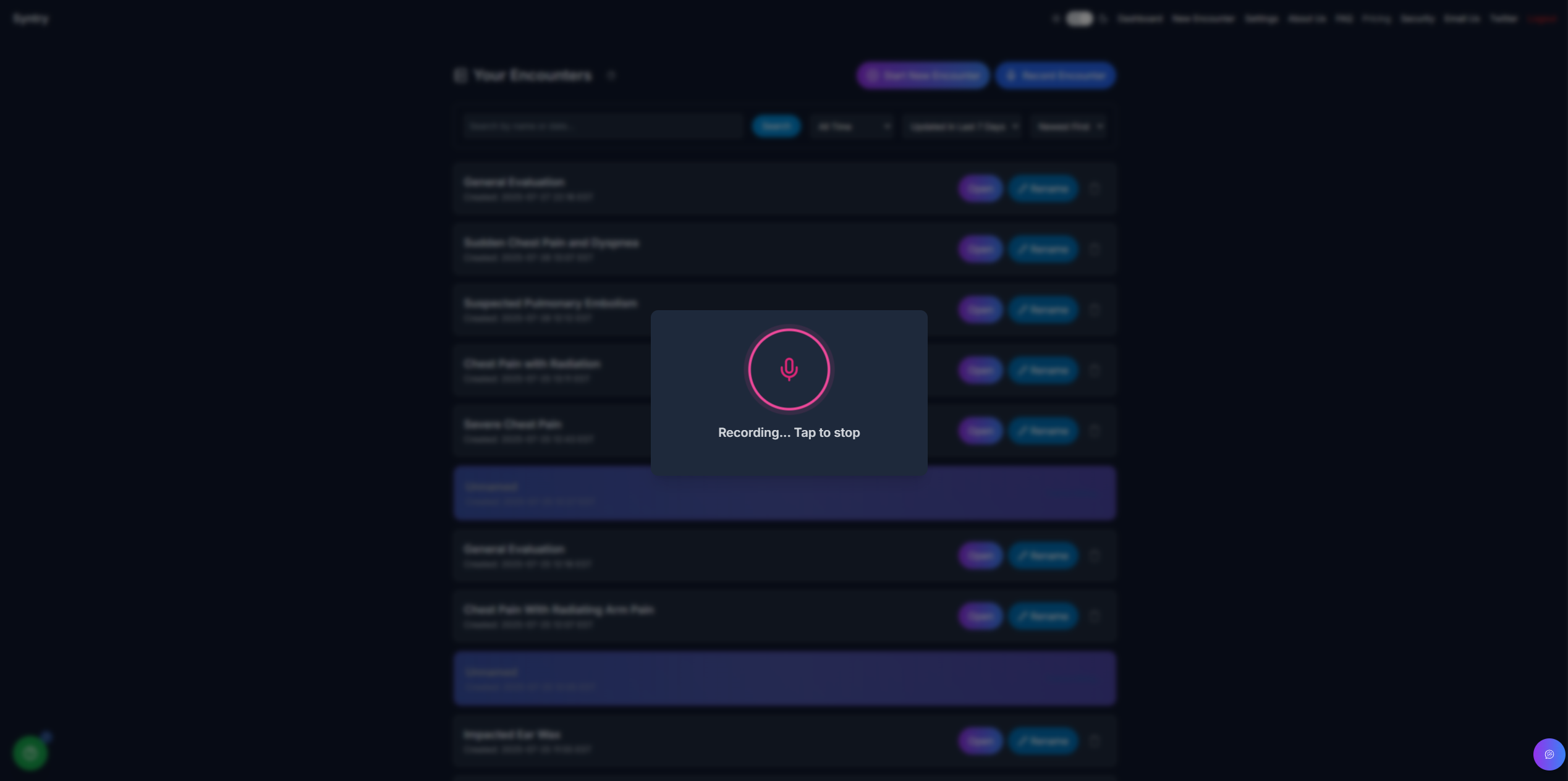
4. Finalize Recording Modal
When you finish recording, a modal appears with three options:
- Finalize: Process the recording and generate your clinical note
- Keep Recording: Continue recording to add more information
- Cancel Recording: Discard the current recording and start over
- Clear visual feedback for each action
- No commitment until you choose "Finalize"
Pro Tip: You can always continue recording if you realize you missed something important. Only finalize when you're completely done with your documentation.
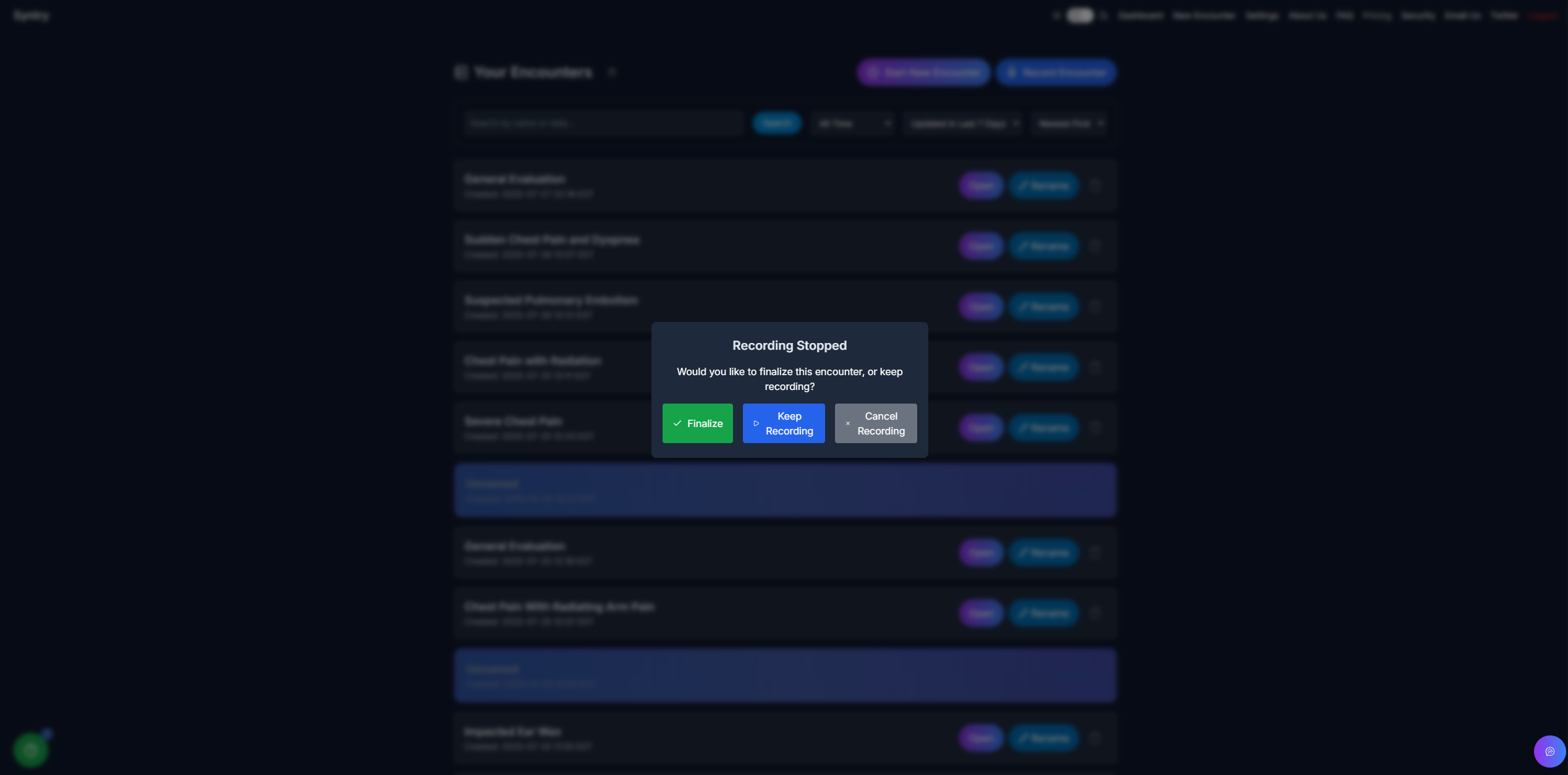
5. Typing Notes Manually
For manual documentation:
- Type directly into any section
- AI assists with formatting and structure
- Switch between documentation styles
- Add, edit, or remove sections as needed
- Auto-save protects your work
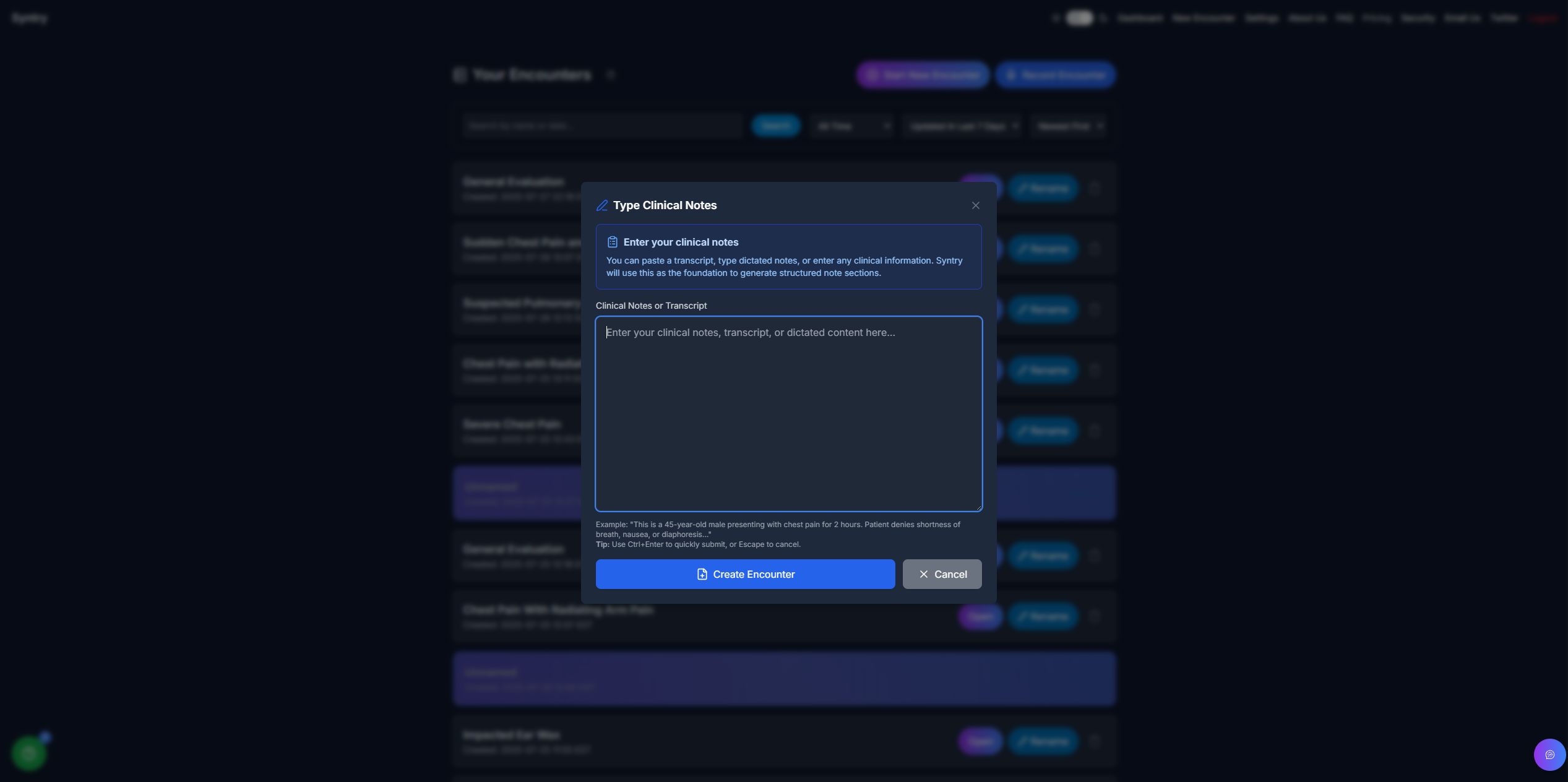
6. Finalizing Your Encounter
Review and finalize your documentation:
- Review all generated sections
- Edit any content as needed
- Add additional notes or sections
- Sign to complete the encounter
- Export or integrate with your EHR
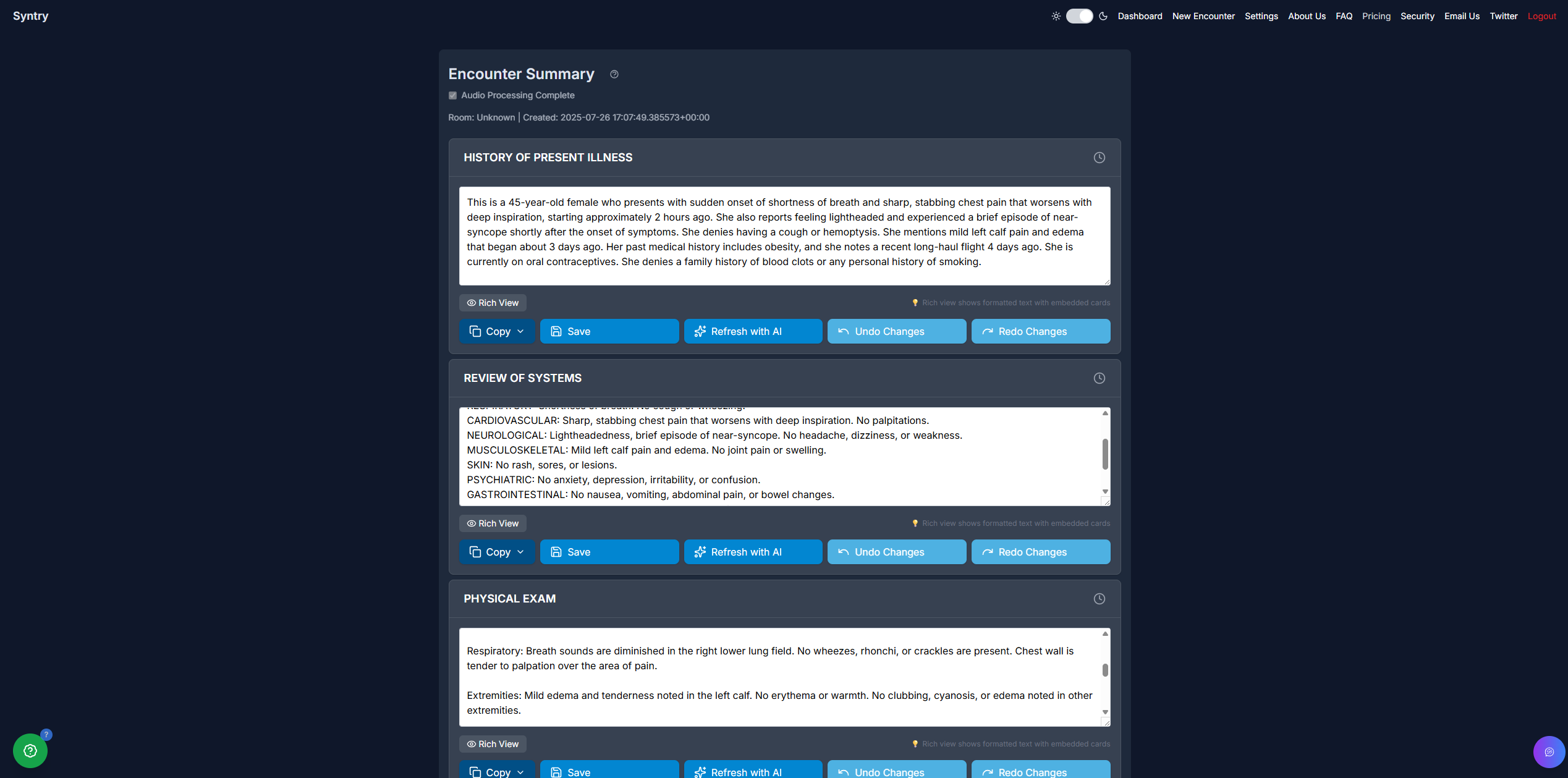
7. Customizing Your Settings
Personalize Syntry to your practice:
- Set preferred documentation styles
- Configure section templates
- Adjust AI assistance levels
- Manage privacy and security settings
- Set up EHR integrations
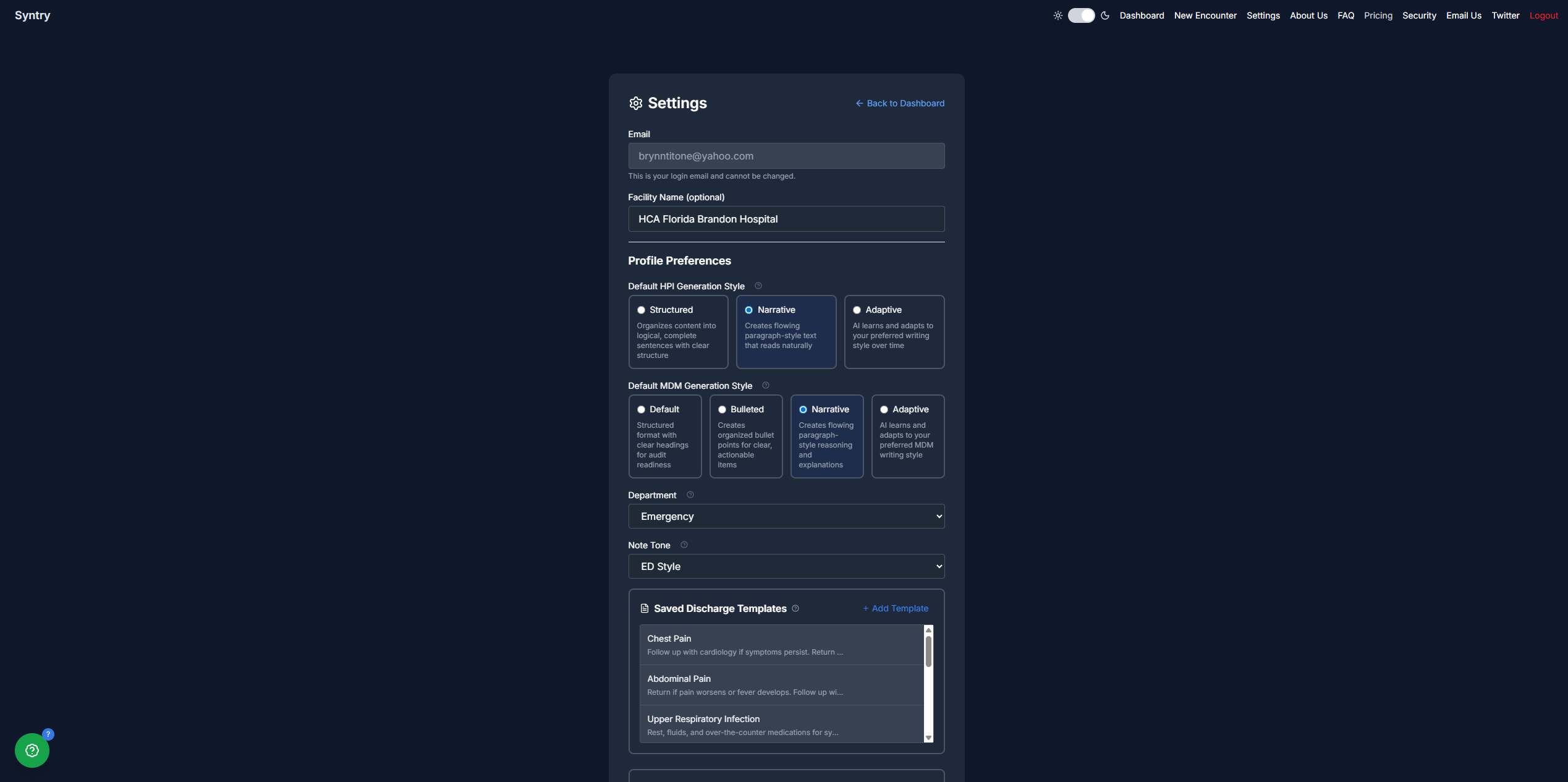
Decision Support Tools
Access evidence-based clinical calculators and decision support tools directly within your documentation workflow:
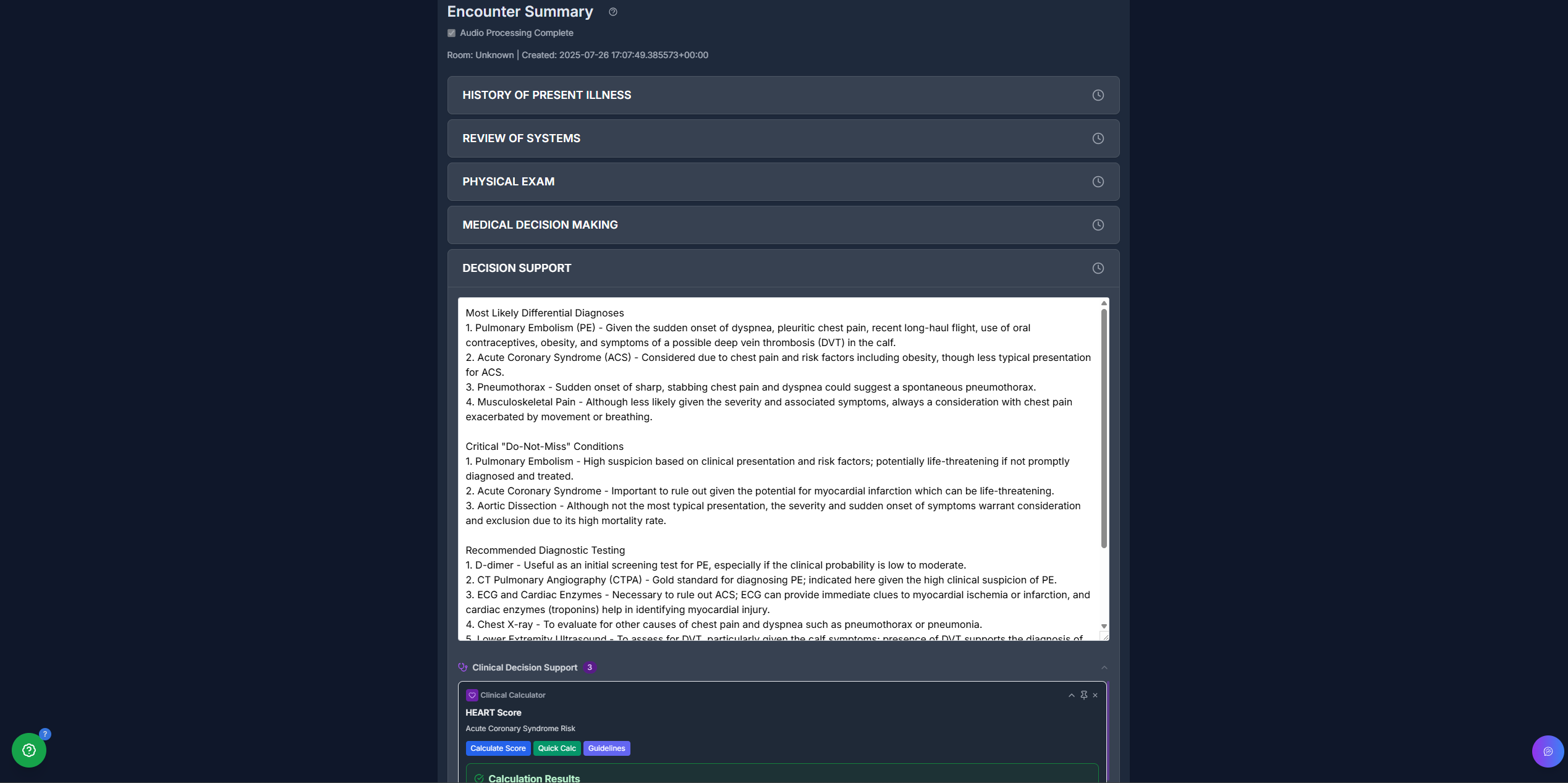
Reassessments & Follow-up Documentation
Efficiently document follow-up visits and reassessments with integrated image upload and progress tracking:
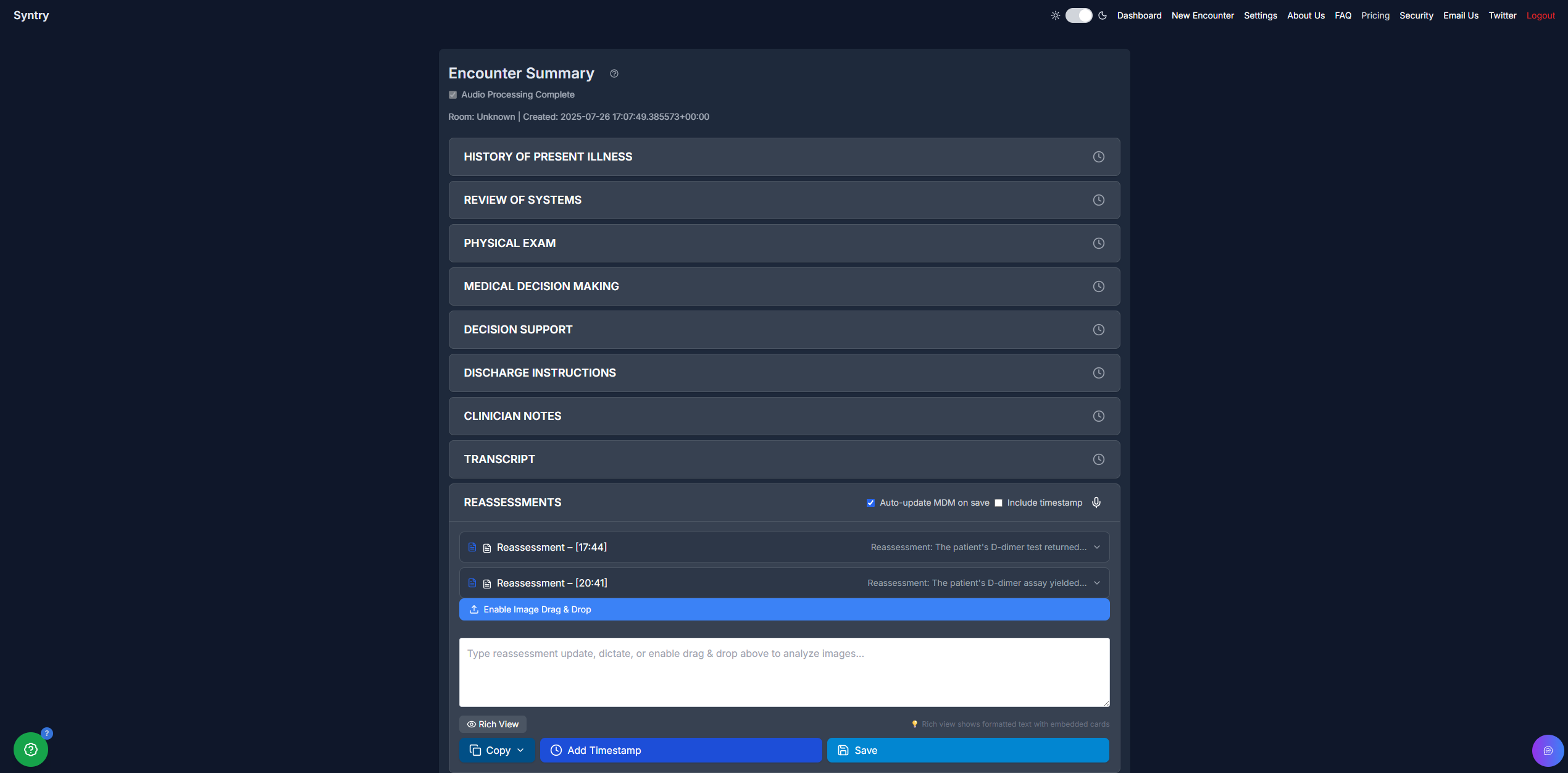
Smart Flow - Intelligent Documentation Workflow
Smart Flow is our adaptive documentation system that learns and evolves with your practice patterns:
User Workflow:
Benefits:
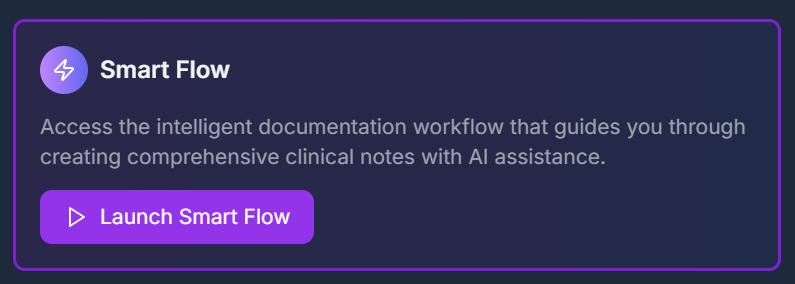

Settings Assistant - AI-Powered Configuration
Let our AI assistant guide you through configuring Syntry for optimal performance in your specific workflow.
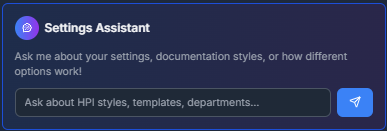
Quick Setup in 3 Steps
Complete How-To Guides
Step-by-step tutorials for every Syntry feature. Master clinical documentation with these comprehensive guides.
How to Record Your First Encounter
Complete Tutorial: From Login to Finished Note
Access Your Dashboard
Log into Syntry and navigate to your encounters dashboard. You'll see all previous encounters and the "Start New Encounter" button.
Click "Start New Encounter"
The prominent purple button opens the encounter options modal with three choices: Type Notes, Record Audio, or Echo Mode.
Select "Record Audio"
Choose the microphone option to begin voice recording. This opens the recording interface with live waveform visualization.
Record Your Clinical Conversation
Speak naturally about the patient encounter. Include history, examination findings, assessment, and plan. The waveform shows real-time audio capture.
Example recording content:
"45-year-old female presenting with chest pain that started 2 hours ago. Pain is sharp, substernal, 7 out of 10, radiating to left arm. Associated with shortness of breath and diaphoresis..."
Stop Recording & Finalize
Tap the microphone circle to stop. Choose "Finalize" to process the audio. The AI immediately begins transcription and note generation.
Review Generated Clinical Note
Your completed encounter appears with all sections: HPI, ROS, Physical Exam, MDM, Decision Support, and Discharge Instructions. Review and edit as needed.
Advanced Recording Techniques
Best Recording Practices
- Speak clearly and at normal pace
- Include specific medical terminology
- Mention normal and abnormal findings
- State your clinical reasoning
What to Include
Common Mistakes to Avoid
- Speaking too quickly or mumbling
- Recording in noisy environments
- Using unclear abbreviations
- Omitting clinical reasoning
Pro Tip
Pretend you're presenting the case to a colleague. This naturally includes all necessary clinical details for comprehensive documentation.
How to Use Echo Mode for Natural Handoff Documentation
Echo Mode: Talk naturally like you're giving report to a colleague
What is Echo Mode?
Echo Mode transforms natural handoff conversations into complete clinical documentation. Simply speak as if you're giving report to a colleague - no need to say "period" or "comma" - just talk naturally and get a comprehensive note.
Natural Handoff Style
Speak conversationally like giving report to a colleague
Complete Note Generation
Generates comprehensive documentation from natural speech
Privacy-First
Audio processed securely, never stored permanently
How to Use Echo Mode
Select "Echo Mode" when starting a new encounter
Speak naturally as if giving handoff to a colleague
Record colleague handoffs (with permission) for instant notes
Add reassessments after seeing the patient post-handoff
Review and finalize your complete documentation
Pro Tip: Perfect for shift changes, patient transfers, and consultation handoffs. No need for formal dictation - just speak naturally!
How to Document Reassessments & Follow-Up Care
Complete Guide: Update existing encounters with new findings and assessments
Access Existing Encounter
Navigate to your encounters dashboard and select the patient encounter you want to update. Click the "Add Reassessment" button to begin.
Choose Documentation Method
Select your preferred input method: Voice Recording for hands-free documentation, Manual Typing for detailed notes, or File Upload for test results and imaging.
Document New Findings
Record or type your reassessment findings, including vital signs, symptom changes, response to treatment, and new clinical observations.
Example reassessment content:
"Patient reassessed after 2 hours. Chest pain improved from 7/10 to 3/10. Vital signs stable. No new symptoms. EKG shows resolution of ST changes..."
Upload Supporting Documents
Drag and drop lab results, imaging studies, or EKGs directly into the reassessment. Synapse AI will analyze and integrate findings automatically.
Auto-Update MDM & Assessment
Watch as the AI automatically updates the Medical Decision Making section, incorporating new data complexity and risk factors into the billing level calculation.
Review Updated Documentation
Your encounter now includes the complete reassessment with timeline, updated assessment and plan, and revised billing documentation reflecting the additional complexity.
Key Features of Reassessments
Auto-MDM Updates
Billing complexity automatically recalculated
Drag & Drop Integration
Upload and analyze supporting documents instantly
Timeline Tracking
Complete chronological record of patient care
Common Reassessment Scenarios
- Post-procedure monitoring
- Response to treatment evaluation
- Lab/imaging result integration
- Shift change handoff updates
Pro Tip
Upload lab results or imaging before dictating your reassessment. Synapse AI will reference the findings in your generated documentation automatically.
Manual Documentation & Smart Templates
When to Use Manual Entry
- Quiet environments where recording isn't practical
- Quick follow-up visits with minimal changes
- Updating specific sections of existing encounters
- Documenting from written notes or memory
Smart Features
AI suggests completions as you type medical terms
Automatic structure and medical language enhancement
Keyboard shortcuts
Ctrl + S
Tab
Ctrl + Space
Ctrl + E
Quick Templates
Type these shortcuts for instant templates:
/normal-pe - Normal physical exam template/chest-pain - Chest pain evaluation template/follow-up - Follow-up visit template/discharge - Discharge instructions templateTroubleshooting Common Issues
Microphone Not Working
Common Causes:
- • Browser permissions not granted
- • Microphone in use by another app
- • Hardware/driver issues
- • Browser doesn't support audio
Solutions:
- • Check browser mic permissions
- • Close other audio apps
- • Try different browser
- • Restart browser/device
Slow Processing or Errors
Possible Issues:
- • Poor internet connection
- • Very long recordings
- • Background noise
- • Server load
Quick Fixes:
- • Check internet speed
- • Keep recordings under 10 minutes
- • Record in quiet environment
- • Try again in a few minutes
Still Need Help?
Our support team is available 24/7 to help resolve any technical issues.
Help Bot AI Assistant
Your intelligent help companion that provides instant answers, guides you through features, and helps troubleshoot issues in real-time.
How to Access Help Bot
The Help Bot toggle is available in your dashboard sidebar for instant assistance.
Help Bot Toggle
Help Bot
AI-powered assistance
Key Features:
- Instant Q&A support
- Feature walkthroughs
- Troubleshooting help
- Context-aware responses
How it Works:
- 1 Toggle Help Bot on/off
- 2 Ask any question
- 3 Get instant guidance
- 4 Follow step-by-step help
Settings Assistant
Help Bot integrates with your settings to provide personalized configuration assistance.
Settings Assistant Panel
"Hi! I'm your Settings Assistant. I can help you configure your workspace, adjust preferences, and optimize your workflow. What would you like to set up today?"
Notifications
Email alerts, push notifications, frequency settings
Templates
Custom templates, auto-fill preferences, snippets
Workflow
Automation rules, shortcuts, integrations
Best Practices for Help Bot
Effective Questions:
- "How do I create a new template?"
- "Show me how to upload images to Synapse"
- "What's the difference between encounter types?"
- "Help with billing codes for critical care"
Tips for Success:
- Be specific about your current task
- Mention the section or feature you're working with
- Follow up with clarifying questions if needed
- Use Help Bot for real-time guidance during tasks
Common Help Scenarios
User: "I can't find where to save my template"
Help Bot: "I'll guide you through saving templates! Look for the 'Save as Template' button in the top right of your document editor. Would you like me to walk you through the entire process step-by-step?"
User: "How do I change my notification settings?"
Help Bot: "Let me help you customize your notifications! Click on your profile icon → Settings → Notifications. From there you can adjust email alerts, push notifications, and frequency. I can also help you set up smart notifications based on your workflow."
User: "What's the best workflow for emergency department documentation?"
Help Bot: "Great question! For ED workflows, I recommend: 1) Start with our ED template, 2) Use quick voice notes for initial assessment, 3) Upload any images to Synapse for analysis, 4) Use auto-complete for common procedures. Would you like me to set up an optimized ED workspace for you?"
Working with Synapse AI Assistant
Learn how to leverage Synapse for clinical decision support, image analysis, and intelligent documentation assistance.
How do I upload images to Synapse?
Synapse accepts medical images through multiple methods for instant analysis and clinical insights.
Upload Methods
Drag & drop files here
or click to browse
Supported Formats
What Synapse Can Analyze
 >
>
ECG Interpretation
Rhythm analysis, arrhythmia detection, interval measurements
 >
>
X-ray Analysis
Abnormality detection, fractures, lung pathology
 >
>
Dermatological Assessment
Rash identification, lesion analysis, skin conditions
 >
>
Lab Interpretation
Value analysis, reference ranges, clinical significance
 >
>
Advanced Imaging
CT/MRI findings, anatomical analysis
 >
>
Wound Assessment
Healing progress, size measurement, care recommendations
Try it yourself!
Upload any medical image and ask: "What do you see in this image?" or "Analyze this ECG/X-ray/rash" for instant clinical insights.
Why Synapse Image Analysis is Highly Accurate
Important Clinical Disclaimer
Synapse is a clinical decision support tool, not a replacement for clinical judgment. All AI interpretations should be reviewed and validated by qualified healthcare professionals. The final diagnosis and treatment decisions always remain with the clinician who has the full clinical context, patient history, and direct patient interaction.
How to interact with Synapse effectively?
Synapse is designed to understand natural medical language and provide comprehensive clinical support.
• Clinical signs of DVT: 3 points
• PE most likely diagnosis: 3 points
• Surgery within 4 weeks: 1.5 points
• Heart rate >100: 1.5 points
Advanced Features
Pro Tips
How does Synapse help with MDM and Discharge Instructions?
Watch how Synapse intelligently updates your Medical Decision Making and generates comprehensive discharge instructions based on your clinical findings.
Smart MDM Updates
- • Analyzes clinical data in real-time
- • Updates complexity level automatically
- • Suggests appropriate billing codes
- • Ensures documentation requirements
Complete DC Instructions
- • Condition-specific guidance
- • Patient-friendly language
- • Safety warnings & red flags
- • Medication reconciliation
Documentation Support
- • Automatically populates encounter
- • Provides follow-up recommendations
- • Generates work/school notes
- • Creates patient education materials
Billing & CPT Coding Assistant
Learn how Syntry's AI helps optimize your billing accuracy and ensures proper documentation for maximum reimbursement.
How does Syntry ensure accurate billing and CPT coding?
Syntry's billing assistant analyzes your documentation in real-time to suggest the most appropriate CPT codes and billing levels based on current CMS guidelines.
Why Syntry's Billing Suggestions are Highly Accurate
Encounter Analysis Summary
Recommended Billing Codes
High complexity emergency department evaluation and management
Documentation Compliance Check
Alternative Billing Considerations
Maximize Revenue
- • Identifies highest appropriate billing level
- • Captures all billable procedures and services
- • Suggests additional documentation for higher levels
- • Prevents under-billing common scenarios
Ensure Compliance
- • Real-time CMS guideline compliance
- • Flags potential audit risks
- • Documentation requirement alerts
- • Modifier suggestions when appropriate
Save Time
- • Instant code suggestions as you document
- • No manual CPT code lookup required
- • Integrated billing summary for easy review
- • Reduces billing staff workload
Important Billing Disclaimer
Syntry provides billing assistance and suggestions, not final billing decisions. All coding and billing decisions should be reviewed by qualified billing professionals or providers. Syntry's suggestions are based on documentation analysis and current guidelines, but the final responsibility for accurate billing remains with the healthcare provider and their billing team. Always verify codes against current CPT and ICD-10 manuals.
Discharge Templates & Snippets
Streamline patient discharge instructions with customizable templates and reusable snippets for consistent, comprehensive patient education.
Discharge Templates
Templates can replace the entire discharge instructions patient education area, or can be integrated into AI-generated instructions for comprehensive patient guidance.
-
Complete Replacement: Use templates as full discharge instruction sets
-
AI Integration: Combine with AI-generated content for personalized instructions
-
Condition-Specific: Create templates for common diagnoses and procedures
Discharge Snippets
Snippets are quick phrases that you routinely include in discharge instructions, ensuring consistent messaging and important safety information.
-
Quick Insertion: Instantly add common phrases and instructions
-
Safety Reminders: "Return to the emergency department or seek emergency medical treatment if symptoms worsen or persist"
-
Standardized Care: Ensure consistent messaging across all patient encounters
Saved Discharge Templates
Saved Discharge Snippets
Settings page showing saved templates and snippets ready for use
How to Create and Use Templates & Snippets
Creating in Settings
-
1Navigate to Settings: Access your settings page from the main menu
-
2Add Templates: Use "Add Template" to create condition-specific instruction sets
-
3Create Snippets: Add common phrases and safety instructions you use frequently
-
4Organize & Edit: Manage your collection with edit, copy, and delete options
Using in Encounters
-
1Open Encounter: Navigate to the discharge instructions section
-
2Insert Template: Select from your saved templates to replace or enhance AI content
-
3Add Snippets: Insert common phrases and safety reminders anywhere in your documentation
-
4Customize: Edit and personalize the content for each patient's specific needs
Common Use Cases & Examples
Popular Template Categories:
- • Chest pain evaluation and follow-up
- • Abdominal pain management
- • Upper respiratory infections
- • Minor injury care instructions
- • Post-procedure care guidelines
Essential Snippet Examples:
- • "Return to ED if symptoms worsen or persist"
- • "Follow up with your primary care provider in 1-2 weeks"
- • "Take medications as prescribed"
- • "Activity restrictions: no heavy lifting for 2 weeks"
- • "Call 911 for severe symptoms"
Pro Tip: Efficient Workflow Integration
Start by creating templates for your most common diagnoses, then build a library of essential safety snippets. This combination ensures consistent, comprehensive patient education while saving significant documentation time. Templates can be used standalone or merged with AI-generated content for the perfect balance of efficiency and personalization.
Copy All Feature
Efficiently copy your entire encounter documentation with one click, formatted for external systems.
How to Copy All Your Documentation
Complete Your Documentation
Finish documenting your encounter with all necessary sections (HPI, ROS, Physical Exam, Assessment & Plan, etc.)
Click "Copy All"
Look for the Copy All button in the top toolbar or use the keyboard shortcut Ctrl+Shift+C (Cmd+Shift+C on Mac)
Choose Your Format
Select from multiple output formats: EMR-formatted text, RTF with formatting, or plain text for maximum compatibility
Paste Into Your EMR
The formatted text is now in your clipboard, ready to paste directly into Epic, Cerner, Athena, or any other EMR system
Copy All - Format Selection
Choose your preferred output format
EMR Format
Optimized for Epic, Cerner, and other major EMR systems
Rich Text (RTF)
Preserves formatting, bold text, and bullet points
Plain Text
Universal compatibility, no formatting
Preview (EMR Format):
HISTORY OF PRESENT ILLNESS:
This is a 45-year-old male presenting with acute onset chest pain...
REVIEW OF SYSTEMS:
Constitutional: Denies fever, chills, weight loss...
PHYSICAL EXAMINATION:
Vital Signs: BP 128/84, HR 88, T 98.6°F, RR 16, O2 Sat 99% on RA
General: Alert, oriented, appears comfortable...
ASSESSMENT AND PLAN:
1. Chest pain, atypical - Consider cardiac vs GI etiology...
Benefits of Copy All
- Save 5-10 minutes per encounter vs manual copying
- Maintains consistent formatting across all EMRs
- Reduces copy-paste errors and missing sections
- Automatically updates when you edit content
Pro Tips
- Use Ctrl+Shift+C for instant copying
- Preview before copying to check formatting
- Customize section order in Settings
- Save custom templates for different EMRs
History & Version Control
Never lose your work. Syntry automatically tracks all changes and saves multiple versions of your documentation.
How History Works for Each Section
Individual Section History
Every edit to your History of Present Illness is saved with timestamps
Physical exam changes tracked separately for easy review
Assessment & Plan revisions preserved with diagnostic reasoning
Complete Encounter History
Encounter History - John Smith
Version history for chest pain encounter
Updated Assessment & Plan with discharge instructions
2 minutes ago • Auto-save
Completed physical examination findings
8 minutes ago • Manual save by Dr. Johnson
Added review of systems - cardiovascular
15 minutes ago • Auto-save
Never Lose Work
- • Automatic saving every 30 seconds
- • Survives browser crashes and network issues
- • Cloud backup of all versions
- • Recovery from any device
Team Collaboration
- • See who made each change
- • Track attending vs resident edits
- • Comment on specific versions
- • Merge changes intelligently
Audit Trail
- • Complete documentation timeline
- • Legal-ready change tracking
- • Export history reports
- • Compliance with record-keeping requirements
Undo/Redo System
Intelligent undo and redo that understands your clinical documentation workflow and preserves your context.
Smart Undo/Redo System
Contextual Undo
Text Changes
Undoes logical text blocks, not individual characters
AI Suggestions
Undo entire AI-generated sections or individual suggestions
Section Changes
Revert entire section additions, deletions, or reorders
Advanced Features
Undo Stack - 8 Actions Available
Recent changes to this encounter
Added "chest pain resolved" to A&P
Assessment & Plan • 1 minute ago
Accepted AI suggestion for physical exam
Physical Examination • 3 minutes ago
Modified HPI - added symptom timeline
History of Present Illness • 5 minutes ago
Preview Next Undo
Will remove: "Patient reports chest pain has completely resolved with rest and is now pain-free."
Edit with Confidence
- • Experiment freely knowing you can undo
- • Try different phrasings without fear
- • Test AI suggestions risk-free
- • Quick recovery from mistakes
Faster Editing
- • No need to manually select and delete
- • Intelligent text block recognition
- • Keyboard shortcuts for speed
- • Visual feedback prevents errors
Advanced Control
- • Selective undo by section
- • Branch from any point in history
- • Undo only AI vs manual changes
- • Merge conflict resolution
Complete User Journey
See how all of Syntry's features work together in a typical clinical workflow, from patient encounter to final documentation.
Patient Encounter Begins
Start your encounter with Syntry's intelligent recording and documentation.
Choose Your Method:
- Live audio recording
- Direct typing/dictation
- Mobile Mic Mode for privacy
Style Selection:
- Structured format
- Narrative style
- Adaptive (recommended)
AI Processing & Enhancement
Syntry's AI automatically processes your input and creates structured documentation.
Smart Transcription
Medical terminology recognition, speaker identification, and noise filtering
Section Organization
Automatic sorting into HPI, ROS, PE, Assessment & Plan sections
Clinical Enhancement
Suggests relevant details, ICD codes, and follow-up actions
Interactive Review & Editing
Use Syntry's powerful editing tools to refine your documentation.
Synapse AI Assistant
- • Upload and analyze medical images
- • Get diagnostic suggestions and MDM help
- • Generate discharge instructions
- • Answer clinical questions contextually
Editing Features
- • Smart undo/redo with 100+ levels
- • Real-time auto-save every 30 seconds
- • Version history and comparison
- • Collaborative editing with team
Quality Assurance & Compliance
Ensure accuracy and compliance before finalizing your documentation.
Billing Analysis
Automatic CPT code suggestions and billing optimization
Compliance Check
Validates documentation completeness and requirements
Quality Review
Grammar check, medical accuracy, and formatting validation
Export & EMR Integration
Seamlessly transfer your completed documentation to your EMR system.
Copy All Feature
- • Multiple format options (EMR, RTF, Plain Text)
- • One-click copy with Ctrl+Shift+C
- • Preview before copying
- • Custom section ordering
Archive & Tracking
- • Complete version history preserved
- • Audit trail for compliance
- • Searchable encounter database
- • Export reports for quality metrics
Complete Workflow Benefits
Save Time
Reduce documentation time by up to 70% with AI assistance and smart features
Ensure Quality
Comprehensive checks for accuracy, compliance, and completeness
Maximize Revenue
Optimal billing codes and documentation for highest appropriate reimbursement
Better Care
More time with patients, improved documentation quality, better outcomes
Pricing & Subscription FAQ
Everything you need to know about Syntry's pricing, payments, and subscription management.
Why is pricing different for Advanced Practice Providers vs Physicians?
Syntry's pricing reflects the income differential between Advanced Practice Providers (NP/PA) and Physicians (MD/DO) in emergency medicine, making our platform accessible and affordable for all provider types.
NP/PA Plan - $79/month
Designed for Nurse Practitioners and Physician Assistants working in emergency medicine
MD/DO Plan - $99/month
Designed for Emergency Medicine Physicians and other attending physicians
Key Points About Our Pricing Structure
- • Same Features: Both plans include all Syntry features - no feature limitations
- • Income-Proportional: Pricing represents similar percentage of income for both provider types
- • Market Research: Based on national salary data from emergency medicine
- • Accessibility: Ensures Syntry is affordable for providers at all levels
- • Fair Value: Same time savings and productivity benefits for everyone
Payment & Subscription Management
Payment Processing
Secure Payments via Stripe
Bank-level security with PCI DSS compliance
Accepted Payment Methods
All major credit cards, debit cards, and ACH transfers
Billing Cycle
Monthly subscription, billed on the same date each month
Invoices & Receipts
Automatic email receipts and downloadable invoices
Instant Activation
Account activated immediately after successful payment
Subscription Management
Account Settings
Manage payment methods and billing info in your account
Pause Subscription
Temporarily pause for up to 6 months (contact support)
Cancel Anytime
No contracts, cancel through account settings or contact support
Access After Cancellation
Continue using Syntry until end of current billing period
How do I cancel my subscription?
Do you offer refunds?
7-Day Trial: Free trial available for new users
Cancellation: No refunds, but you keep access until period ends
Special Circumstances: Contact support for billing issues or technical problems
Unused Time: We don't prorate refunds for partial months
Can I change my payment method?
Easy Updates: Change cards anytime in Account Settings
Multiple Cards: Store backup payment methods
Failed Payments: We'll retry failed payments and notify you
Billing Alerts: Get notified before card expiration
Is there a free trial?
7-Day Free Trial: Full access to all features
No Credit Card: Sign up without payment information
Trial Features: Create unlimited encounters, use all AI features
Easy Upgrade: Subscribe anytime during or after trial
What happens if my payment fails?
Automatic Retry: We retry failed payments 3 times over 10 days
Email Notifications: You'll be notified of payment issues immediately
Grace Period: 10-day grace period to update payment method
Account Suspension: Access suspended after grace period ends
Do you offer discounts?
Annual Billing: Save 20% with annual subscriptions (coming soon)
Group Discounts: Special pricing for healthcare organizations (contact sales)
Student Rates: Discounted pricing for residents and students
Non-Profit: Special pricing available for qualifying organizations
How to Subscribe to Syntry
Subscription Process
Visit Pricing Page
Review plans and choose Monthly or Annual billing
Select Your Provider Type
Choose NP/PA or MD/DO pricing tier
Secure Stripe Checkout
Complete payment using our secure Stripe integration
Instant Account Activation
Start using Syntry immediately after payment
Secure Payment Features
SSL Encryption
All payment data encrypted in transit
PCI DSS Compliant
Bank-level security standards
No Data Storage
Syntry never stores your payment information
Automatic Renewals
Seamless subscription management
Enterprise & Special Plans
Healthcare Organizations
- • Custom pricing for 10+ users
- • Advanced admin controls
- • Priority support
- • Custom integrations
Residents & Students
- • 50% discount on standard pricing
- • Verification required
- • All standard features included
- • Educational support resources
Locum Tenens
- • Flexible monthly plans
- • No long-term commitments
- • Multi-facility support
- • Quick setup and training
Frequently Asked Questions
Find quick answers to the most common questions about Syntry's features, security, and workflow.
Is Syntry HIPAA Compliant?
Yes. Syntry follows HIPAA guidelines and offers signed BAAs to covered entities. All data is encrypted, access is controlled, and we maintain comprehensive audit trails.
Can I edit my AI-generated notes?
Absolutely. You have complete control over all generated content. Edit, add, remove, or restructure any part of your documentation before finalizing.
What happens to my audio recordings?
Audio recordings are never stored permanently. They are processed for transcription and immediately deleted. Only your final, signed clinical notes are retained.
How does the Mobile Mic Mode work?
Mobile Mic Mode is designed for healthcare providers who need hands-free recording while keeping their phone in their pocket or coat. The black screen prevents accidental taps that could stop recording and lose valuable patient encounter data.
How to Use Mobile Mic Mode
Privacy & Security
- • Black screen protects patient privacy
- • No visible interface during encounters
- • Prevents accidental screen captures
- • HIPAA-compliant design
Workflow Benefits
- • Hands-free operation during exams
- • No risk of accidentally stopping recording
- • Continuous recording in pocket/coat
- • Focus entirely on patient care
Pro Tips for Mobile Mic Mode
Can I use Syntry on mobile devices and tablets?
Syntry provides full mobile compatibility with optimized touch interfaces for healthcare professionals on the go.
Mobile Features
- Responsive Design: Adapts perfectly to smartphone and tablet screens
- Touch-Optimized: All features accessible via touch interface
- Mobile Voice Recording: High-quality audio capture on mobile devices
- Offline Capability: Basic functionality available without internet connection
- Cross-Device Sync: Seamless synchronization across all your devices
Device Support
Mobile-Specific Features
- Camera Integration: Direct photo capture for medical imaging
- Push Notifications: Real-time alerts for important updates
- Biometric Security: Fingerprint and face unlock compatibility
Pro Tip: Start an encounter on your mobile device during patient rounds, then seamlessly continue documentation on your desktop workstation. All data syncs in real-time for maximum workflow flexibility.
How accurate is the AI transcription?
Our AI transcription is highly accurate, especially for medical terminology. However, we always recommend reviewing and editing your notes before finalizing to ensure accuracy and completeness.
Pro Tips for New Users
Still Have Questions?
We're here to help! Contact us for personalized support and guidance.
Get Direct Support
Our team is ready to help with setup, troubleshooting, and optimization of your Syntry workflow.